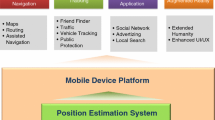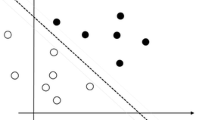Abstract
Wireless Local Area Network (WLAN) positioning has become a popular localization system due to its low-cost installation and widespread availability of WLAN access points. Traditional grid-based radio frequency (RF) fingerprinting (GRFF) suffers from two drawbacks. First it requires costly and non-efficient data collection and updating procedure; secondly the method goes through time-consuming data pre-processing before it outputs user position. This paper proposes Cluster-based RF Fingerprinting (CRFF) to overcome these limitations by using modified Minimization of Drive Tests data which can be autonomously collected by cellular operators from their subscribers. The effect of environmental changes and device variation on positioning accuracy has been carried out. Experimental results show that even under these variations CRFF can improve positioning accuracy by 15.46 and 22.30% in 95 percentile of positioning error as compared to that of GRFF and K-nearest neighbour methods respectively.



Similar content being viewed by others
References
E. Kaplan, C. Hegarty, Understanding GPS: Principles and Applications. Artech House, Inc., 2005.
M. Anisetti, C. A. Ardagna, V. Bellandi, E. Damiani and S. Reale, Map-based location and tracking in multipath outdoor mobile networks, IEEE Transactions on Wireless Communications, Vol. 10, No. 3, pp. 814–824, 2011.
J. H. Kim, K. S. Min, W. Y. Yeo, A design of irregular grid map for large-scale Wi-Fi LAN fingerprint positioning systems, The Scientific World Journal, Vol. 2014, ID 203419, 2014.
X. Liu, S. Zhang, J. Quan, X. Lin, The experimental analysis of outdoor positioning system based on fingerprint approach. In 12th IEEE International Conference on Communication Technology (ICCT), pages 369–372, Nanjing, China, 2010.
M. Yousief, Horus: A WLAN-Based Indoor Location Determination system, in PhD thesis, University of Maryland, 2004.
A. Kushki, K. N. Plataniotis and A. N. Venetsanopoulos, Kernel-based positioning in wireless local area networks, IEEE Transactions on Mobile Computing, Vol. 6, No. 6, pp. 689–705, 2007.
Skyhook. In Global 1st Party Location Network. http://www.skyhookwireless.com/about-skyhook. Accessed 24 Dec 2016.
K. Li, P. Jiang, E. L. Bodanese and J. Bigham, Outdoor location estimation using received signal strength feedback, IEEE Communications Letters, Vol. 16, No. 7, pp. 978–981, 2012.
R. Singh, L. Macchi, C. S. Regazzoni, K. N. Plataniotis. A statistical modelling based location determination method using fusion technique in WLAN. In International Workshop on Wireless Ad-Hoc Networks, London, UK, 2005.
J. Talvitie. Algorithms and Methods for Received Signal Strength Based Wireless Localization, in PhD thesis, Tampere University of Technology, 2016.
J. Johansson, W. A. Hapsari, S. Kelley and G. Bodog, Minimization of drive tests in 3GPP release 11, IEEE Communications Magazine, Vol. 50, No. 11, pp. 36–43, 2012.
3GPP TR 36.805. Study on minimization of drive-tests in next generation networks. Accessed Dec 2009.
M. H. A. Meniem, A. M. Hamad, E. Shaaban. Relative RSS-based GSM localization technique. In IEEE International Conference on Electro/Information Technology (EIT), pages 1–6, South Dakota, USA, 2013.
T. Hiltunen, R. U. Mondal, J. Turkka, T. Ristaniemi. Generic architecture for minimizing drive tests in heterogeneous networks. In IEEE 82nd Vehicular Technology Conference (VTC Fall), pages 1–5, Boston, USA, 2015.
M. Bshara, U. Orguner, F. Gustafsson and L. V. Biesen, Fingerprinting localization in wireless networks based on received signal-strength measurements: a case study on WiMAX networks, IEEE Transactions on Vehicular Technology, Vol. 59, No. 1, pp. 283–294, 2010.
H. Liu, Y. Zhang, X. Su, X. Li, N. Xu, Mobile localization based on received signal strength and Pearson’s correlation coefficient, International Journal of Distributed Sensor Networks, Vol. 2015, ID. 157046, 2015.
T. Wigren, Adaptive enhanced cell-ID fingerprinting localization by clustering of precise position measurements, IEEE Transactions on Vehicular Technology, Vol. 56, No. 5, pp. 3199–3209, 2007.
M. Youssef, A. Agrawala, A. U. Shankar. WLAN location determination via clustering and probability distributions. 1st IEEE International Conference on Pervasive Computing and Communication (PerCom 2003), pages 143–150, Texas USA, 2003.
Y. Chen, Q. Yang, J. Yin and X. Chai, Power-efficient access-point selection for indoor location estimation, IEEE Transactions on Knowledge and Data Engineering, Vol. 18, No. 7, pp. 877–888, 2006.
E. Laitinen, E. S. Lohan, J. Talvitie, S. Shrestha. Access point significance measures in WLAN-based location. In 9th Workshop on Positioning Navigation and Communication (WPNC), pages 24–29, Dresden, Germany 2012.
P. Bahl and V. Padmanabhan, RADAR: An in-building RF-based user location and tracking System, IEEE INFOCOM, Vol. 2, pp. 775–784, 2000.
M. H. N. Hossain, Van, Y. Jin, W. S. Soh. Indoor localization using multiple wireless technologies. In IEEE MASS, Pisa, Italy, 2007.
M. B. Kjærgaard, C. V. Munk. Hyperbolic location fingerprinting: A calibration-free solution for handling differences in signal strength. In 6th Annual IEEE International Conference on Pervasive Computing and Communications (PerCom 2008), pages 110–116, Hong Kong, 2008.
3GPP TR 37.834, Study on WLAN/3GPP radio interworking. Vol. 1.0.0, 2013.
Nemo Handy: handheld drive test software, http://www.anite.com/businesses/network-testing/products/nemo-handy-world’s-most-widely-used-handheld-drive-test-tool#.Vc8_nPmqpBd. Accessed June 2016.
C. Feng, W. S. A. Au, S. Valaee and Z. Tan, Received-signalstrength-based indoor positioning using compressive sensing, IEEE Transactions on Mobile Computing, Vol. 11, No. 12, pp. 1983–1993, 2012.
I. J. Quader, B. Li, W. Peng, A. G. Dempster. Use of fingerprinting in Wi-Fi based outdoor positioning. In International Global Navigation Satellite Systems Society IGNSS Symposium, The University of New South Wales, Sydney, Australia, 2007.
F. Yu, M. Jiang, J. Liang, X. Qin, M. Hu, T. Peng, X. Hu, 5G WiFi signal-based indoor localization system using cluster k-nearest neighbor algorithm, International Journal of Distributed Sensor Networks, Vol. 2014, ID 247525, 2014.
P. Berkhin, Survey of Clustering Data Mining Techniques, Grouping Multidimensional DataSpringer, Berlin Heidelberg, 2006. pp. 25–71.
A. Razavi, M. Valkama, E. S. Lohan. K-Means fingerprint clustering for low-complexity floor estimation in indoor mobile localization. In IEEE GLOBCOM Workshop on Localization and Tracking: Indoors, Outdoors and Emerging Networks, Washington DC, USA, 2015.
A. Arya, P. Godlewski, M. Campedel and G. Che´ne´, Radio database compression for accurate energy-efficient localization in fingerprinting systems, IEEE Transactions on Knowledge and Data Engineering, Vol. 25, No. 6, pp. 1368–1379, 2013.
A. David, S. Vassilvitskii. K-means ++: The advantages of careful seeding. In 18 th Annual ACM-SIAM Symposium on Discrete Algorithms (SODA 2007), pages 1027–1035, Louisiana, United States, 2007.
A. C. Rencher, Methods of Multivariate Analysis. Wiley, Inc., 2002.
A. Arya, P. Godlewski, P. Melle. A hierarchical clustering technique for radio map compression in location fngerprinting systems. In International Conference on Vehicular Technology, pages 1–5, Taipei, China, 2010.
D. L. Davies, D. W. Bouldin, A cluster separation measure, IEEE Transactions on Pattern Analysis and Machine Intelligence, Vol. PAMI-1, No. 2, pp. 224–227, 1979.
H. Zhou, N. N. Van. Indoor fingerprint localization based on fuzzy C-means clustering. In 6th International Conference on Measuring Technology and Mechatronics Automation, pages 337–340, China, 2014.
D. J. Suroso, P. Cherntanomwong, P. Sooraksa, J. Takada. Location fingerprint technique using Fuzzy C-Means clustering algorithm for indoor localization. In IEEE TENCON, Indonesia, 2011.
J. C. Bezdec, Pattern Recognition with Fuzzy Objective Function Algorithms, Plenum PressNew York, 1981.
R. Xu, D. C. Wunsch II, Clustering, John Wiley and Sons, Inc., 2009.
O. A. Abbas, Comparisons between data clustering algorithms, The International Arab Journal of Information Technology, Vol. 5, No. 3, pp. 320–325, 2008.
X. Liu, S. Zhang, H. Lu, X. Lin. Method for efficiently constructing and updating radio map of fingerprint positioning. In IEEE GLOBCOM 2010 Workshop on Heterogeneous, Multi-hop Wireless and Mobile Networks, pages 74–78, Florida, USA, 2010.
M. Raitoharju, H. Nurminen, R. Piché, Kalman filter with a linear state model for PDR + WLAN positioning and its application to assisting a particle filter, EURASIP Journal on Advances in Signal Processing, 2015.
E. Ertin and K. Priddy. Self-localization of wireless sensor networks using self-organizing maps. In Proceedings of SPIE, 2005.
G. Giorgetti, S. K. S. Gupta, G. Manes. Wireless localization using self-organizing maps. In Proceedings of IPSN’07, pages 25–27, Massachusetts, USA, April 2007.
T. Mantoro, M. A. Ayu, A. Nuraini, S. M. Amin. Self-organizing map approach for determining mobile user location using IEEE 802.11 signals. In Proceeding of International Symposium on Information Technology (ITSim), Kuala Lumpur, Malaysia, 2010.
Acknowledgements
The authors would like to thank colleagues from University of Jyvaskyla and European Communications Engineering, Finland for their constructive criticism, comments and support.
Author information
Authors and Affiliations
Corresponding author
Rights and permissions
About this article
Cite this article
Mondal, R.U., Ristaniemi, T. & Turkka, J. Cluster-Based RF Fingerprint Positioning Using LTE and WLAN Signal Strengths. Int J Wireless Inf Networks 24, 413–423 (2017). https://doi.org/10.1007/s10776-017-0369-9
Received:
Accepted:
Published:
Issue Date:
DOI: https://doi.org/10.1007/s10776-017-0369-9




